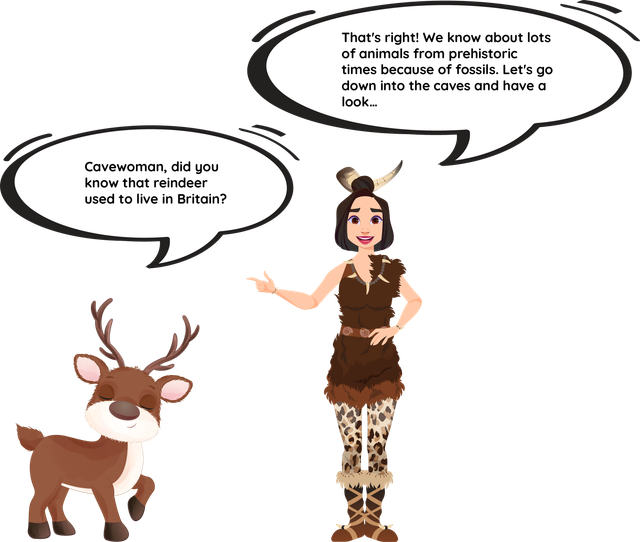How fossils are formed
KS2 geography
At Stump Cross Caverns, we're nuts about fossils.
Join Rowan the Reindeer and Cavewoman to learn about how they're formed and what they can tell us.

Today, reindeer live in cold, cold climates – places like Norway, Siberia and Canada. But believe it or not, they used to live in Britain too.
Yes, once upon a time you didn't just see them in Christmas movies. They lived in Britain until around 1100.
We know what they looked like and where they lived because of fossils. They're a record of the past that we've dug up, piece by piece. Without them, we might never know about dinosaurs. But what are fossils, exactly?
What are fossils?
Fossils are the preserved remains of dead animals and plants. They're found in rocks and come in all different shapes and sizes.
At Stump Cross, diggers found four reindeer skeletons that were almost complete! But look in the gift shop and you'll see smaller shells, bones and other sea creatures.
Fossils can be thousands, millions or even billions of years old. A lot of the plants and animals found in the rocks have become extinct, meaning they no longer live on earth.
What is the fossil record?
One fossil on its own can't tell us much about the past. That's why scientists look at the fossil record – a collection of all the fossils that have ever been found.
The fossil record is like a giant jigsaw puzzle. Each fossil tells us a little bit more about the story of life on earth and how organisms have changed over time.
It's a puzzle that we'll probably never finish. After all, most animals and plants never became fossils in the first place – and lots have been destroyed or just never found.
But each new fossil gives us a little bit more information about our planet and all the species that have lived on it.
Where do fossils come from?
The process of turning into a fossil is called fossilisation – and it takes a long, long time.
When a dinosaur died, its body rotted away, leaving the skeleton behind. It got covered in sediment – little bits of rock, sand and mud.
More time passed. The dinosaur's skeleton was squashed by the sediment and eventually the bone became rock. Water seeped in and the bones dissolved, leaving a mould.
This mould was then filled with minerals from the water – and the fossil was formed!
Thousands of years later, the rocky record is still there. It can show us what dinosaurs looked like then and where in the world they lived.
Stump Cross Caverns
Greenhow Hill
Pateley Bridge
Yorkshire
HG3 5JL
All Rights Reserved | Stump Cross Limited
Crafted with creativity and marketing savvy by My Digital Hero